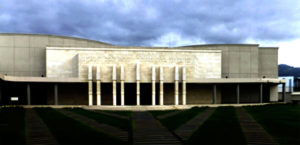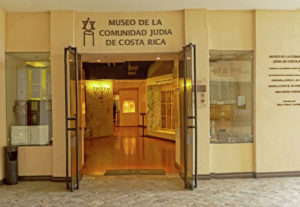 The first Jews to come were Conversos fleeing the Inquisition. These Jews lived in the Central Valley, mixing with the larger society, intermarrying and assimilating, eventually abandoning their observance of Judaism altogether.
The first Jews to come were Conversos fleeing the Inquisition. These Jews lived in the Central Valley, mixing with the larger society, intermarrying and assimilating, eventually abandoning their observance of Judaism altogether.
Jews also arrived in Costa Rica from islands in the surrounding Caribbean in the 19th century. However, the first real wave of Jews came to Costa Rica in the 1920s and 1930s fleeing persecution and economic hardship in Eastern Europe, primarily from two villages in Poland. These Jews worked as peddlers, going door to door, knocking and selling. They were called Klappers, or Polacos, terms that are now used to mean any peddler.
After the Holo caust, a second group of 100 Jews landed in Limon, on the Caribbean coast, seeking refuge. According to the law, all immigrants were required to show that they had $25. The Jews arrived nearly penniless, but someone had $25, which, after being shown was passed to the next in line. The Customs Officials knew exactly what was going on, but allowed the Jews to enter because they understood that they were concentration camp survivors who needed a home. Close to 200 Holocaust survivors still live in San Jose, the capital.
caust, a second group of 100 Jews landed in Limon, on the Caribbean coast, seeking refuge. According to the law, all immigrants were required to show that they had $25. The Jews arrived nearly penniless, but someone had $25, which, after being shown was passed to the next in line. The Customs Officials knew exactly what was going on, but allowed the Jews to enter because they understood that they were concentration camp survivors who needed a home. Close to 200 Holocaust survivors still live in San Jose, the capital.
The third wave of immigration occurred in the 1970’s as political and military repression swept Latin America; Jews fled to Costa Rica because it had no military, was a democracy.
 In recent years, a fourth wave of Jewish immigration has boosted the local population, largely composed of the growing number of expatriate American retirees who are moving to Costa Rica as well as a number of Israeli transplants settling here and starting businesses. Some estimate that there are 300 Israelis living permanently in Costa Rica. Other estimates are 40-50 Israeli families. These include some Israelis who have married Costa Rican Jewish girls and have settled there either to enter the family business or to establish businesses financed by the girl’s family, as is customary in the country. There are other Israelis who simply wandered through and found this was a good place to make a living so they settled down. There are still others who came with the various Israeli projects in Costa Rica. Tahal has water projects, there are agricultural projects of various kinds, and others as well. So Israelis come through on a temporary basis all the time.
In recent years, a fourth wave of Jewish immigration has boosted the local population, largely composed of the growing number of expatriate American retirees who are moving to Costa Rica as well as a number of Israeli transplants settling here and starting businesses. Some estimate that there are 300 Israelis living permanently in Costa Rica. Other estimates are 40-50 Israeli families. These include some Israelis who have married Costa Rican Jewish girls and have settled there either to enter the family business or to establish businesses financed by the girl’s family, as is customary in the country. There are other Israelis who simply wandered through and found this was a good place to make a living so they settled down. There are still others who came with the various Israeli projects in Costa Rica. Tahal has water projects, there are agricultural projects of various kinds, and others as well. So Israelis come through on a temporary basis all the time.
The Je ws built Costa Rica’s first synagogue, the Orthodox Shaarei Zion, in 1933 in the capital of San José. Another synagogue is B’nai Israel (Reform), established in 1987, and largely catering to American ex pats. In 2004, the Centro Israelita completed construction of a new facility. Built of Jerusalem stone and local materials, the centre houses the 1,000-seat Shaarei Zion Synagogue. This synagogue features separate seating for women in the balcony, a wood-beamed ceiling, a wooden Torah Ark with blue curtain and a central bima.
ws built Costa Rica’s first synagogue, the Orthodox Shaarei Zion, in 1933 in the capital of San José. Another synagogue is B’nai Israel (Reform), established in 1987, and largely catering to American ex pats. In 2004, the Centro Israelita completed construction of a new facility. Built of Jerusalem stone and local materials, the centre houses the 1,000-seat Shaarei Zion Synagogue. This synagogue features separate seating for women in the balcony, a wood-beamed ceiling, a wooden Torah Ark with blue curtain and a central bima.
All denominations of the community revolve around the Centro Israelita Sionista founded in 1930. It has offices in a vast compound encircled by a massive wall over 15 feet high. Behind that protective wall lies the Shaarei Zion Synagogue, the museum of the Jewish community, and a cemetery. The Jewish cemetery in San Juan, also has a Holocaust memorial to Jewish victims. There is kosher food and a mikvah.
The Haim Weizmann Comprehensive School is an Orthodox day school located in San Jose and has more than 350 pupils in kindergarten, primary, and secondary grades; the languages of instruction are Spanish and Hebrew. Most Jewish children attend the Haim Weizmann primary and secondary school.
The Jewish community is around 3,000, but there may be another 1,500 hidden Jews, including American retirees who have settled in Costa Rica.